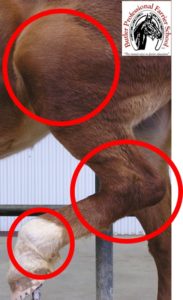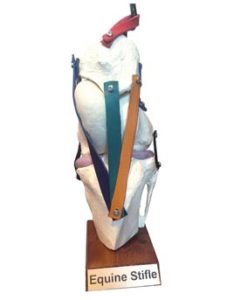Equine Stifle Model
Few anatomical structures of the horse are as fascinating as the stifle joint. The stifle joint is located in the hind limbs between the femur and tibia. It is comparable to the human knee complete with a patella (knee cap). The hind limbs of the horse have a propelling function, driving the horse forward. The stifle joint is directly connected to the hock and fetlock joints. This allows the hind limb to move in unison. This is called the reciprocal apparatus.

The reciprocal apparatus of the horse causes the stifle, hock and fetlock to flex in unison. The hock and fetlock must do what the stifle does. If the stifle is locked in a rigid position, the hock and fetlock will be as well.
The reciprocal apparatus is comprised of the superficial flexor tendon, peroneus tertius and gastrocnemius. Another word for reciprocal might be interdependent or corresponding. The stifle in the upper part of the limb controls the hock and fetlock in the middle and lower part of the limb. Put simply, if the stifle bends, the hock and fetlock must bend as well. This is why a horse’s hind legs folds up underneath it. This is easiest to see when the farrier places the horse’s hind foot in his or her lap or on the hoof stand in order to clinch the nails. Pulling a leg out directly behind a horse (as advocated by some trainers) is a bad idea as it can injure the reciprocal apparatus and prevent it from working properly.
Horses also have a unique ability to rest while standing up. This is called the stay apparatus. Horses are able to lock their limbs in place so that they can sleep without falling down. Humans don’t have the stay apparatus. A horses’ stay apparatus works because it has a reciprocal apparatus. All they have to do is lock the stifle in place and the hock and fetlock automatically become rigid.
The stay apparatus in the hind limb is located in the stifle. It is called the medial patellar ligament. When the medial patellar ligament (attached to the patella or knee cap) locks over the trochlea (protrusion or ridge) of the femur, the hind limb is locked in place and the horse can go to sleep without fear of falling over. When the horse wants to unlock the entire limb, the medial patellar ligament simply must slide back over the ridge to allow movement. Every time the horse takes a step, the stifle is locking and unlocking.
Sometimes, the medial patellar ligament gets stuck. Horsemen call this a “stifled horse.” Another name for it is the “upward fixation of the patella.” When this happens, the limb is locked in place even though the horse may be trying to move. The result is a stiff leg that drags behind the horse. This may not be a problem if it is only temporary. Some horses develop this on a cold morning but as they warm up, they unlock the stifle with no problem. The stifle may also get stuck in the locked position from trauma, or poor conformation. Horses with very straight hind legs are much more likely to develop stifle problems.
In rare instances, horses might not be able to unlock the stifle at all or for long periods of time. Dragging the hind foot along hard ground can wear the foot away, exposing sensitive structures, and causing further pain to the horse. A competent veterinarian can perform a surgery called a “medial patellar desmotomy” where he or she cuts the offending ligament. The stifle immediately unlocks but will never be able to lock again. The disadvantage is that the horse will no longer be able to rest standing up. However, laying down to sleep is a small price to pay to have mobility of the hind limbs back again!
 To better understand this unique mechanism of the horse, the Equine Stifle Model is now available to own. The model can be used to explain the reciprocal apparatus, stay apparatus, stifle lameness like upward fixation of the patella, arthritis and osteochondritis dessicans. It is a practical visual aid to carry in your horseshoeing or veterinarian rig to help explain anatomical function and possible lameness issues with your clients. Horse owners appreciate a visual reference as you explain what is going on with their horses. The model also works well for demonstrations to pony clubs and 4-H groups. Whether you are preparing to take a certification exam, increasing your value as a trusted consultant, or a horse owner wanting to better understand your own horse, this model is a helpful tool.
To better understand this unique mechanism of the horse, the Equine Stifle Model is now available to own. The model can be used to explain the reciprocal apparatus, stay apparatus, stifle lameness like upward fixation of the patella, arthritis and osteochondritis dessicans. It is a practical visual aid to carry in your horseshoeing or veterinarian rig to help explain anatomical function and possible lameness issues with your clients. Horse owners appreciate a visual reference as you explain what is going on with their horses. The model also works well for demonstrations to pony clubs and 4-H groups. Whether you are preparing to take a certification exam, increasing your value as a trusted consultant, or a horse owner wanting to better understand your own horse, this model is a helpful tool.
Related Posts
-
-
Each one of us needs to face the fact that we are not going ...Jun 06, 2019 / 0 comments
-
Happy New Year! The New Year brings with it a determination ...Jan 30, 2015 / 0 comments
Blog Categories
- Anatomy
- Best Business Practices
- Conformation
- Current Events
- Customer Service
- Draft Horse Shoeing
- Equine Soundness
- Essential Anatomy Kit
- Farrier Careers
- Farrier training
- Foal soundness
- Horse Care
- Horse Foot Care
- Horse Owner Tips
- Horsemanship
- Horseshoeing
- Horseshoeing History
- Iron and Forge Work
- Student Spotlight
- Uncategorized
- Veterinary Care
Blog Archives
Contact Us
Butler Professional Horseshoeing School
495 Table Road
Crawford, NE 69339
(800) 728-3826
jacob@dougbutler.com
Subscribe to Our Blog
Get Our Free e-Book!
If you think you want to become a farrier (or know someone who does), this book can help you make that decision. Horse owners will learn the importance of choosing a qualified farrier and how to select the “right” one.
[ Get the e-Book Now! ]
- Follow:
